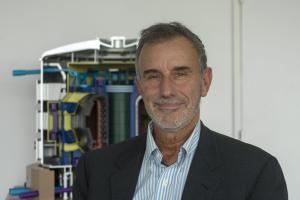Intégrité et intégration
Parlez-nous de votre expérience au JET...
C'était très enthousiasmant. L'équipe, dirigée par des personnalités remarquables, était légère et réactive. J'ai eu la chance de travailler de manière étroite avec des gens comme Peter Noll, Michel Huguet, Enzo Bertolini, ou encore Paul-Henri Rebut. Je m'occupais de l'alimentation électrique et du design des bobines internes de la machine. En fait, on touchait un peu à tout, ce qui nous permettait de comprendre de manière intime ce qu'est un tokamak.
En 1992 s'ouvre la phase des Engineering Design Activities (EDA) d'ITER et vous, ainsi que d'autres au JET, ralliez le projet. ITER, c'était quoi à l'époque ?
Même si on ne tarderait pas à construire des maquettes et des prototypes, c'était encore un « projet de papier ». Les équipes étaient basées sur trois sites, l'un à Münich-Garching en Allemagne, l'autre à San Diego en Californie où j'étais affecté, et le troisième à Naka, au Japon. Le projet était dirigé par Robert Aymar, que je considère comme mon mentor... Je n'étais pas toujours d'accord avec lui, mais c'était un vrai privilège de travailler à ses côtés.
En dépit de la complexité de l'organisation et de la distance géographique entre les trois sites—il faut se souvenir que les outils ne communication dont nous disposons aujourd'hui n'existaient pas encore—le travail pour les EDA était tout à fait passionnant. Nous nous familiarisions avec les différents systèmes de la machine, comment ils fonctionneraient et s'intégreraient les uns aux autres mais je ressentais un manque. Au JET, je mettais mes mains dans le cambouis. Et là, il n'y avait pas encore de machine, et encore moins de cambouis. Ne pas me servir de mes mains me frustrait et je trompais ma frustration en restaurant des voitures de sport pendant mon temps libre.
Et puis, il y avait la politique. Je sais bien que, sans « politique » il n'y aurait pas d'ITER. Mais j'avais le sentiment que les interférences politiques, ajoutées à la complexité du projet, auguraient mal de son succès. En 2006, après m'être fortement impliqué dans les négociations sur le choix du site de construction, j'ai eu besoin d'une pause.
Et c'est là qu'un autre tokamak entre dans votre vie...
Peu de temps après la signature de l'accord « Approche élargie » entre l'Europe et le Japon, on m'a demandé de prendre la direction du projet JT-60SA qui, bien plus qu'une mise à niveau du tokamak japonais JT-60U, consistait à construire une machine complètement nouvelle, dotée entre autres d'aimants supraconducteurs. Après mon expérience au JET, puis au cours de l'ITER EDA, j'étais extrêmement motivé par ce nouveau projet. Nous avons consacré deux ans à élaborer un nouveau design pour la machine et nous avons développé le modèle de management que j'avais espéré mettre en œuvre pour ITER au temps de l'EDA. Ce modèle a été très bien reçu par l'ensemble des participants au programme. Travailler au JT-60SA a été pour moi une très belle aventure, et je crois qu'elle l'a été également pour tous ceux qui y ont pris part et qui la perpétuent aujourd'hui.
Après avoir dirigé le programme JT-60SA, vous prenez la responsabilité de l'ensemble de l'Approche élargie, qui inclue les projets IFMIF/EVEDA et IFERC. Et en 2015 vous posez votre candidature au poste de directeur général d'ITER Organization.
J'étais totalement investi dans JT-60SA à l'époque et je n'avais pas vraiment envie de quitter le programme. L'idée de diriger ITER ne me soulevait pas d'enthousiasme, mais, disons que l'on m'a fortement encouragé à candidater...
Et l'enthousiasme est venu en 2022 ?
Je crois que, quand on veut quelque chose avec trop d'intensité, on risque de ne pas être très efficace... ITER est un énorme défi, et le programme connaît de sérieuses difficultés. Ce que je ressens à ce stade, et de manière très profonde, c'est que je peux contribuer au succès d'ITER.
De quelle manière ?
C'est une question d'efficacité des procédures et, plus encore, une question de culture. Nous avons besoin de définir la façon dont nous allons nous réorganiser, sans opérer forcément de réforme spectaculaire. Nous devons nous demander comment améliorer la collaboration, comment mieux intégrer les Agences domestiques. Les personnels d'ITER Organization et ceux des Agences domestiques doivent être placés sur un pied d'égalité et œuvrer aller dans la même direction—après tout, les enjeux sont les mêmes pour tous. A deux reprises, en 2015 et plus récemment au mois de juin 2022, j'ai assuré l'intérim de la direction de l'Agence domestique européenne (Fusion for Energy), qui gère la contribution de l'Europe à ITER. J'ai acquis une certaine expérience des interactions entre une Agence domestique et ITER. J'ai compris qu'il fallait simplifier nos procédures, utiliser des outils communs, projeter une image commune et ne jamais oublier que nous construisons ensemble une infrastructure de recherche commune. Au niveau symbolique, quelque chose me frappe : les Agences domestiques ont chacune leur logo, ITER Organization a son logo mais le programme ITER, lui, n'en a pas. À mes yeux c'est le signe évident de notre absence de culture commune—il nous manque le symbole qui exprimerait notre unité. Je sais que tout cela ne va pas de soi. Mais il y a un effort à faire.
Récemment, en vous adressant pour la première fois à l'ensemble du personnel, vous avez dit que la valeur cardinale, pour vous, c'était « l'intégrité ». Qu'est-ce que vous entendez par là ?
Nous devons cesser de nous voiler la face devant les problèmes que nous rencontrons. Plus on travestit la réalité, plus elle reviendra se venger. Dans une entreprise aussi unique et inédite que la nôtre, les problèmes, les défis, les déconvenues et les erreurs sont inévitables. Alors débarrassons-nous de ce sentiment de crainte que l'on sent percer dans les rapports et les interactions ; débarrassons-nous de tout ce qui peut être antagoniste dans la culture présente d'ITER.


